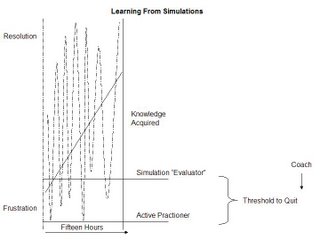Coaches can be co-located or remote, synchronous or asynchronous.
At least three factors drive the need for coaches
- The divergence of the learning (increase need for coaching)
- The importance that the learning actually occurs (increase need)
- How well designed the sim is (decrease need)
SimuLearn has two master-level coaches, Graham Courtney and Tom Parkinson (Tom seen here with an US Army group). Their mantra is: "Our role is 99% to motivate. Let the simulation do the teaching." This is really hard for so many people with training backgrounds, who are, by necessity, control freaks.
is: "Our role is 99% to motivate. Let the simulation do the teaching." This is really hard for so many people with training backgrounds, who are, by necessity, control freaks.
Coaches can give specific assignments, break students into teams, ask students to redo, or skip ahead. They can run facilitated group sessions. They can sometimes explain parts of the simulation. They can make issues more specific (many of our coaches review 360 data before students begin taking the simulations). They can do live After Action Reviews or review uploaded or submitted AAR data hours or days later. And they can still grade.
Preparing coaches requires a facilitator's guide and even a train the trainer program, all typically part of the simulation deliverable.
This role, from being a traditional instructor to be a coach, has often been talked about. But simulations provide a transition strategy for instructors to leverage many of their traditional skills to increase their own value considerably to end-learners.
 Simulations do not smooth out the peaks and valleys (or perhaps, but only minimally), as much as compress them and make them more predictable.
Simulations do not smooth out the peaks and valleys (or perhaps, but only minimally), as much as compress them and make them more predictable. The valleys present a bit of problem, however, not in the learning (where they are critical), but in the expectation of the sim experience.
The valleys present a bit of problem, however, not in the learning (where they are critical), but in the expectation of the sim experience.  There is a "threshold to quit" for different end-learners, that if the experience dips below the threshold, the learner will opt out of the course with a negative bias.
There is a "threshold to quit" for different end-learners, that if the experience dips below the threshold, the learner will opt out of the course with a negative bias.








